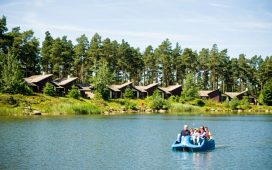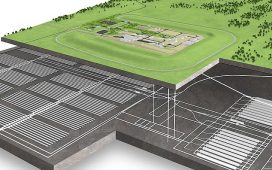It was a morning of brooding green banks and dark skies on the River Tweed. Heavy rains had hit southern Scotland and the waterway had turned into a fast flood, with the deluge sweeping our two-seater canoe downstream through farmland and fishing beats as fast as a salmon escaping a rod and reel.
The river, usually easy to navigate and at times only a few feet deep, had swollen fat, the rush of water pushing out in oily swirls that ambushed us. Our pace was frenzied, the spray cold and fresh. But my mood was upbeat because this was why I had come: to see the Anglo-Scottish borderlands from a new perspective.
Times are changing on the Tweed. A world-class salmon fishing river in a valley with a recent history of hosting blockbuster events, including last summer’s UCI mountain bike world championships, the waterway is now looking to canoeing for its latest lure. The Tweed Valley Canoe Trail officially launches today (1 May) and, open to the thrill of a gentle paddle as much as whitewater, I had come to the Borders for a two-day preview of the 30-mile route on its upper reaches.
“You’re seeing the genesis of the trail, without its makeup on,” my guide, Craig Reid of Biggar Adventure, told me, at the starting point just outside Stobo, back in September. “It’s not the Zambezi, but the Tweed has its moments, meeting somewhere at the intersection of soft adventure and meditation. It’s peaceful, yet rewarding.” Anything I shouldn’t do? “Travel sideways in the fast flow,” he replied. I must have looked a trifle nervous.
The Upper Tweed valley may be the UK’s hottest UK river destination this summer, but it helps that the new canoe trail is manageable for first-time, have-a-go paddlers, as well as those who fancy more of a challenge, on its Grade 2 rapids. The trail has been divided into six bite-size sections between Stobo and Tweedbank, ranging from two to eight miles.
Light-touch infrastructure is now appearing along the riverside. That includes storage racks and anchor points for tying up safely, signposts and info panels. The project’s developer, Go Tweed Valley, is also working on increasing the number of paddler-friendly accommodation options to add to the already-present campsites. Free waterproof trail maps are available from outdoor shops in Peebles and Innerleithen, or there’s a digital version on Go Tweed Valley’s site. There are places to rent equipment in the Tweed valley and further afield in Edinburgh (such as Kayak and SUP Hire and Sales or Driftwood Adventure).
Our vessel was a 35kg Canadian canoe with a flat bottom (making it less manoeuvrable but more stable), large enough to carry two with overnight dry bags. Dippers and kingfishers whirred in flight and a great blue heron looked on as we took our first few strokes. May and June are when you see flotillas of fluff-ball ducklings, Craig said. September, at the paddling season’s end, is for salmon leaping right over your canoe. In the months between, otters make camp on the verges.
For all the innovation of the trail, the Tweed valley retains a remarkably old-fashioned set of Scottish ideals at its heart. The catch-and-release fly fishing is as good as anywhere, and there are sporting estates, historic textile mills and grand baronial halls that tell of the Borders’ historic role in the days of Mary, Queen of Scots and James VI.
Before Peebles, the great bulk of Neidpath Castle appeared, looking particularly impressive from the water. By the time we reached Toll Wood at Innerleithen, a two-hour paddle away, we had shot through the middle of a salmon ladder, and passed gillie huts and a few JR Hartley types in green twill unspooling fishing lines from the bank. It was like a Constable landscape brought to life.
The painter’s contemporary, Walter Scott, also revered the British countryside. The writer’s story is inseparable from the Borders and Traquair House, a rambling old hunting lodge where we were staying the night. Scott regularly visited Traquair, largely because of his friendship with then owner Lady Louisa Stuart. Dating from 1107, it conveniently sits on a curve of the Tweed next to a new pull-out point and a wild campsite.
We followed a path to the house, for a hot bath and ale from the brewery housed in wing directly beneath the 1829 chapel. That only gives a hint of Traquair’s history. The main house, riotous with crooked stairs and a secret escape route used by Catholics during the Reformation, overlooks the B&B, whose rooms are crowded with canopied beds and antique furnishings. Rising behind that is a garden with a statue of cupid stringing his bow.
Guidebook author Rich Rowe and freelance writer Lindsay Quayle, two outdoorsy types based in Peebles who are the brains behind the trail, joined us for a pie and a pint at the nearby Traquair Arms hotel. The Tweed remains undiscovered, they said, but also has to be treated differently from other rivers.
“A river like the Tay has long been open to rafting and adventure water-sports operators,” said Rich, over a Tempest Brewing Co pale ale from nearby Tweedbank. “That history isn’t present here,” added Lindsay. “So there needs to be sensitivity to the traditional users, particularly the fly fishers hooking salmon and trout. Us canoeists are the new kids.”
On our second morning, the river seemed pacified, its eddies less violent, and Craig was relaxed enough to allow me to take breaks to absorb the highlights. As per his instructions, I balanced my paddle on my lap to view the banks and take notes on my phone as we crossed ancient fords and muddled under bridges through Walkerburn and Glenkinnon. We were soon passing the ruined Elibank Castle, then pulling up short of Yair Bridge, a triple-arched stone crossing and the precursor to the Fairnilee rapids, the wildest stretch on the trail.
Before us were moshing waves, some a metre or so high, others waltzing to a haphazardly conducted symphony of rolls and splashes. Craig, at the back, regained steerage position, his wooden paddle giving more purchase on the curling water than my blade, then we rolled through and under the bridge, not gently, but head-on. It turns out there is a very fine line between calm and collected and soaking wet pants, and, after a wave tipped over the gunwales, we both burst out laughing.
Our adventure slowly came to an end, first curving south, then back north on a last stretch that lead to the grand finale: Abbotsford, Walter Scott’s time-warp gothic estate. Seen from the water, the country pile takes on a different personality – more secretive, more stately – and it looms over the river like a monumental finishing line. Imagine Balmoral on the Thames. The day glittered and the sun lit the river’s way east to Kelso, where it pushes on beneath the Cheviot Hills to the estuary at Berwick-upon-Tweed and into the North Sea.
In the sunshine, my drying trousers were a witness to the great trip we’d had. Two hundred years ago, Scott might have been surprised to see two canoeists hauling out a vessel just steps from where he captured the beauty of the Tweed from his study window. He knew it was a bonny part of the country, but today the river is about to be discovered by a whole new audience. As with each paddle forward, there are always two longing looks back.
For more information on the Tweed Valley Canoe Trail, see gotweedvalley.co.uk. Accommodation was provided by Traquair House (doubles from £175 B&B, traquair.co.uk). For guided canoe trips, equipment rental and transfers, visit biggaradventure.co.uk. A guided three-hour trip costs from £45pp. For further information, visit scotlandstartshere.com











